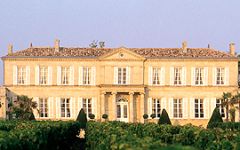Chateau Branaire-Ducru 2015
-
Wine
Enthusiast -
Wine
Spectator -
James
Suckling - Decanter
-
Robert
Parker



Product Details
Your Rating
Somm Note
Winemaker Notes
#33 Wine Spectator Top 100 of 2018
An attractive bouquet of red and black fruit, lovely and fresh, clear-cut and complex. Dense and round on the palate, it is powerful yet elegant.
Blend: 65% Cabernet Sauvignon, 26% Merlot, 5% Petit Verdot, 4% Cabernet Franc
Professional Ratings
-
Wine Enthusiast
This family-owned estate has produced a structured and dark wine with great concentration balanced by acidity and pure, creamy fruit. It is a wine with a good future. The aftertaste leaves juicy acidity and firm tannins. Drink from 2025.
-
Wine Spectator
This pumps lush fig, boysenberry and blackberry confiture notes along, pushed by a rather polished but ample structure. Lots of anise and violet details cascade in on the finish, giving this extra aromatic dimension. Best from 2020 through 2038.
-
James Suckling
Quite ripe with aromas of currants, violets, rich dark plums, dark chocolate, graphite and toasty cedary oak. Really complex. The palate has impressive polish and depth. Very supple and smooth tannins, carrying long, bright flavors of plums and dark cherries. Superb. Best from 2022.
-
Decanter
Stepping up in terms of grip and acidity, this really does pull you along through the palate, while bristling tannins hold things together. This majors on control and well-drawn cassis and bilberry fruits. It needs to soften, but should really go the distance. A fine and classic St-Julien. Drinking Window 2025 - 2040
-
Robert Parker's Wine Advocate
Medium to deep garnet-purple in color, the 2015 Branaire-Ducru has an earthy nose over a core of red and black currants with hints of tapenade, pencil shavings and sage. The medium-bodied palate is firm and chewy, with just enough fruit and a lively finish.
Other Vintages
2022-
Robert
Parker -
James
Suckling - Decanter
- Vinous
-
Jeb
Dunnuck
-
James
Suckling - Vinous
-
Robert
Parker - Decanter
-
Jeb
Dunnuck
-
James
Suckling - Decanter
-
Wine
Enthusiast -
Wine
Spectator -
Robert
Parker -
Jeb
Dunnuck
-
Jeb
Dunnuck -
Wine
Enthusiast -
Robert
Parker -
James
Suckling -
Wine
Spectator - Decanter
-
James
Suckling -
Wine
Enthusiast -
Jeb
Dunnuck -
Wine
Spectator -
Robert
Parker - Decanter
-
Wine
Enthusiast -
Jeb
Dunnuck -
Wine
Spectator -
James
Suckling -
Robert
Parker
-
Wine
Spectator -
James
Suckling -
Wine
Enthusiast -
Robert
Parker - Decanter
-
Jeb
Dunnuck
-
Wine
Enthusiast -
Wine
Spectator -
James
Suckling
-
Wine
Enthusiast -
James
Suckling -
Wine
Spectator -
Robert
Parker
-
Wine
Enthusiast -
Robert
Parker -
James
Suckling -
Wine
Spectator
-
Wine
Enthusiast - Vinous
-
James
Suckling - Decanter
-
Wine
Spectator -
Robert
Parker
-
Jeb
Dunnuck -
Wine
Enthusiast -
James
Suckling -
Robert
Parker -
Wine
Spectator
-
Robert
Parker -
Wine
Enthusiast -
Wine
Spectator
-
Wine
Enthusiast
-
Wine
Enthusiast -
Wine
Spectator -
Robert
Parker
-
Wine
Enthusiast -
Robert
Parker
-
Robert
Parker -
James
Suckling -
Wine
Spectator -
Wine
Enthusiast
-
Robert
Parker
-
Wine
Spectator -
Robert
Parker


The name, given by the former owner Monsieur Ducru, means "beautiful pebbles". One of the main features of the vineyard is its richness in pebbles which contribute to the greatness of so many wines of the Medoc.
Just before the war, the vineyard became run down and many Bordeaux critics felt it no longer deserved its rank as a Second Growth. During the Medoc Classification of 1855, the Chateau was rated as a Fourth Growth. In 1942 the Borie family purchased the vineyard completely revamped the vineyard and it began receiving top ratings amongst the Second Growths. Successive generations of the Borie family oversee all winemaking operations.

One of the world’s most classic and popular styles of red wine, Bordeaux-inspired blends have spread from their homeland in France to nearly every corner of the New World. Typically based on either Cabernet Sauvignon or Merlot and supported by Cabernet Franc, Malbec and Petit Verdot, the best of these are densely hued, fragrant, full of fruit and boast a structure that begs for cellar time. Somm Secret—Blends from Bordeaux are generally earthier compared to those from the New World, which tend to be fruit-dominant.

An icon of balance and tradition, St. Julien boasts the highest proportion of classed growths in the Médoc. What it lacks in any first growths, it makes up in the rest: five amazing second growth chateaux, two superb third growths and four well-reputed fourth growths. While the actual class rankings set in 1855 (first, second, and so on the fifth) today do not necessarily indicate a score of quality, the classification system is important to understand in the context of Bordeaux history. Today rivalry among the classed chateaux only serves to elevate the appellation overall.
One of its best historically, the estate of Leoville, was the largest in the Médoc in the 18th century, before it was divided into the three second growths known today as Chateau Léoville-Las-Cases, Léoville-Poyferré and Léoville-Barton. Located in the north section, these are stone’s throw from Chateau Latour in Pauillac and share much in common with that well-esteemed estate.
The relatively homogeneous gravelly and rocky top soil on top of clay-limestone subsoil is broken only by a narrow strip of bank on either side of the “jalle,” or stream, that bisects the zone and flows into the Gironde.
St. Julien wines are for those wanting subtlety, balance and consistency in their Bordeaux. Rewarding and persistent, the best among these Bordeaux Blends are full of blueberry, blackberry, cassis, plum, tobacco and licorice. They are intense and complex and finish with fine, velvety tannins.
